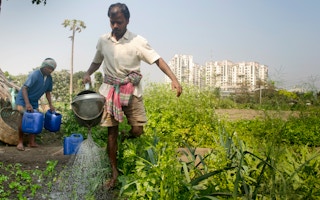Some 60 per cent of Delhi’s demand for meat is fulfilled by city-grown produce, as is 25 per cent of its milk and 15 per cent of its vegetable needs. Yet policies on land use and farming in the National Capital do not acknowledge the role of cultivation and distribution of food in urban areas, says a new draft policy by Delhi-based research non-profit People’s Resource Centre.
The “Draft Citizen’s Policy for Urban Agriculture in Delhi”, submitted to the Delhi government in September 2022, aims to provide a holistic framework for urban farming. It recommends building on existing practices, promoting residential and community farming through rooftop and kitchen gardens, allocating vacant land for agricultural use, creating a market, developing policies for animal rearing and spreading awareness.
These recommendations are crucial to ensure food security for urban communities. This benefit has long been highlighted in arguments for urban farming.
Rapid urbanisation, population explosion and climate change increases the risk of food shortage, says a 2017 study published in the International Journal on Emerging Technologies.
Similarly, a 2010 report by M S Swaminathan Research Foundation, Chennai, notes that 50 per cent of women and children in urban areas are anaemic due to lack of adequate nutrition. Both studies recommend urban agriculture.
Globally, in 2020, the UN Food and Agriculture Organization acknowledged that urban and periurban farming can contribute to local food and nutritional needs, enable jobs and reduce poverty.
In India, urban farming has seen some traction across states, prompting governments to introduce small-scale initiatives to promote the practice. In 2008, Pune’s civic administration launched a city farming project to train and encourage people to take up farming on allocated land.
Anita Pinheiro, a doctoral candidate at Jawaharlal Nehru University, who has also consulted on People’s Resource Centre’s draft policy, cites Kerala’s example.
The state had been food dependent until 2012, she tells Down to Earth (DTE), when the state government launched a vegetable development programme to encourage gardening in houses, schools, government and private institutions.
“
Compared to commercial farming, hydroponics requires 90 per cent lesser water, which can be reused. One can grow more plants in the space given.
Garima Parekh, farmer, Mumbai
It also offered subsidy and support for eco-friendly inputs, irrigation, compost and biogas plants. According to Kerala State Planning Board, vegetable production rose from 825,000 tonnes in 2011-12 to 1.3 million tonnes in 2014-15.
Similarly, in 2014, the Tamil Nadu government introduced a “do-it-yourself” kit for city dwellers to grow vegetables on rooftops, houses and apartment buildings under its Urban Horticulture Development Scheme. Since 2021, Bihar encourages terrace gardening in five smart cities through subsidy for input cost.
Integration is key
While such initiatives are welcome, their impact cannot be expected to be widespread without a strong policy for urban farming. For instance, Pune’s 2008 initiative failed to take off due to poor interest from people and the government.
Even the recently released draft Master Plan of Delhi for 2041, does not acknowledge the role of the practice. It aims to divide 8,000 hectares of land along the Yamuna into two sub-zones and restrict human activity or settlement in areas directly adjacent to the river.
However, several communities on the floodplains practise urban farming. “If this (draft master plan) comes into practice, informal settlements like Chilla Khadar and Bela Estate will lose the agricultural land,” says Nishant, a founding member of the People’s Resource Centre and co-author of the non-profit’s draft policy.
Rapid development is also a hindrance. Citing the example of Jaunti village in Delhi, where the Green Revolution began, Paras Tyagi from Centre for Policy Research, Centre for Youth Culture tells DTE, “It has become an ‘urban village’, making its land non-agricultural. Farmers cannot avail benefits under any agricultural schemes such as crop insurance.” Hence, to promote urban farming, Nishant says governments must recognise informal practices and link them with agricultural schemes.
There is also a need to make urban agriculture viable. Farming in cramped urban spaces marred by water scarcity and pollution is not easy. A 2016 paper titled Future of Urban Agriculture in India by the Hyderabad-based Institute for Resource Analysis and Policy mentions that in Delhi, Hyderabad, Ahmedabad and Chennai, wastewater is directly or indirectly used for urban farming.
Studies show that excessive use of chemical fertilisers and pesticides in urban farms can lower produce and soil quality. However, urban farmers believe such hurdles can be overcome with innovative techniques.
Garima Parekh, a resident of Mumbai, says that hydroponics, a method of soilless farming that uses nutrient solutions to sustain plants, offers a cleaner approach.
“Compared to commercial farming, hydroponics requires 90 per cent lesser water, which can be reused. One can grow more plants in the space given,” she says. However, she admits that markets for such initiatives are still niche and at a nascent stage.
Pinheiro says even such innovations, cannot match the scale of rural agriculture. “Kitchen gardening or small-scale community farming cannot sustain the large population, but can act as a cushion to protect urban residents from inflation, vulnerabilities of weather or crises such as Covid-19,” she says. Before more villages become urban, early interventions can result in a sustainable system.
This story was originally published on Down to Earth.










